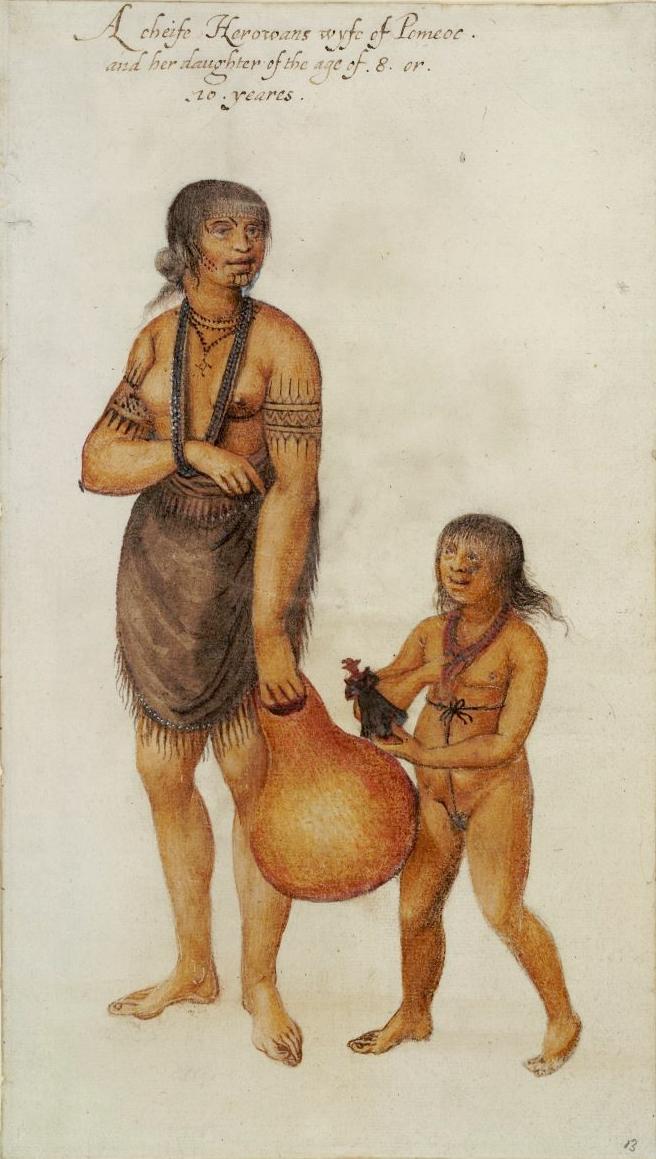
Eastern Woodlands Language Groups: The Algonquian-speaking Peoples

Figure 1.-- John White, an English artist and cartographer was part of an English effort to plant a colony on what is now the Outer Banks of North Carolina. It was a plan devised by Sir Walter Raleigh to settle 'Virginia' -- of course the name devised to honor Queen Elizabeth I-- 'The Virgin Queen' (1585). Roanoke Island was the first English settlement in North America, but was abandoned other mysterious cicumstances. White remained on Roanoke Island for about 13 months before returning to England. He produced over 70 watercolor drawings of the indigenous people, plants, and animals. It was the first encountered of the English with Algonquian-speaking people at the southern limit of their expanse. The French at the same time were also coming in contact with Algonquian-speaking people, mostly to the north. White's paintings are the first detailed depictions of the Algonquian-speaking peoples. This one shows shows a native mother with her child. The mother's right hand is slung through a bead necklace made of copper, shells, pearls, amd/or bone. This suggests high status. We also see a European doll held by the little girl. This was not a cheap trade good nd also suggests the child was from a high status family. The inscription reads, "A cheife Herowans wyfe of Pomeoc. / and her daughter of the age of .8. or. / 10. yeares." Pomeiooc (modern spelling ) was a palisaded town in the Outer Banks near the English settlement whose weroance, or chief, was Piemacum (modern spelling). The English with White appear to have visited the town in July 1585. Source: British Museum.
|
|
The Algonquian are a major North America Native American language group with destinct regional variations. They were one of the largest and most widely dispersed of the major language groups. Algonquian speaking tribes were prevalent in what is now eastern Cnada (including Labrador) from the Atlantic coast west to the Great Lkes and throughout the northeast quadrant of the modern United sTates. Algonquian-speaking tribes dominated along the Atantic coast as far south as North Carolina. As a result, they were the tribes encounteed by the early English settlers. The first English settlers at Jamestown encountered the Powhatan. The subsequent Englih settlers in Plymouth Colony encountered several different Algonquian-speaking tribes. The various tribes were diverse. And while they shared linguistic rellations, this is not mean the various tribes were linguistially inteligibe. This varied from trobe to tribe. There were also shared cultural practices, but this also varied from tribe to tribe. Some of the tribes had developed agriculture, but not peranent settlement. And some of the tribes had not yet developed agriculture in a majpr way. Most Algonquian-speaking tribes lived primarily by hunting and fishing and gatering nuts, berries, and roots. Many tribes had begun to supplement their diets by growing corn, beans and squash--often referred to as the 'Three Sisters'. The Ojibwe (Chippewa) people of south-eastern Canada were known for growing wild rice. Economic practives varied regionally depending in part on local resources and climate.
HBC

Navigate the Boys' Historical Clothing Web Site:
[Return to the Main U.S. history page]
[About Us]
[Introduction]
[Activities]
[Biographies]
[Chronology]
[Clothing styles]
[Countries]
[Bibliographies]
[Contributions]
[FAQs]
[Glossaries]
[Images]
[Links]
[Registration]
[Tools]
[Boys' Clothing Home]
Navigate the Boys' Historical Clothing ethnic pages:
[Return to the Main Eastern Woodlands Tribes page]
[Return to the Main ethnic page]
[German]
[Greek]
[Irish]
[Scottish]
Navigate the Boys' Historical Clothing Native American pages:
[Return to the Main Native American cultural area page]
[Return to the Main Native American ethnic page]
[Return to the Main Native American page]
[Ethnic]
[Dance]
Created: 12:35 PM 4/13/2017
Last updated: 12:35 PM 4/13/2017



